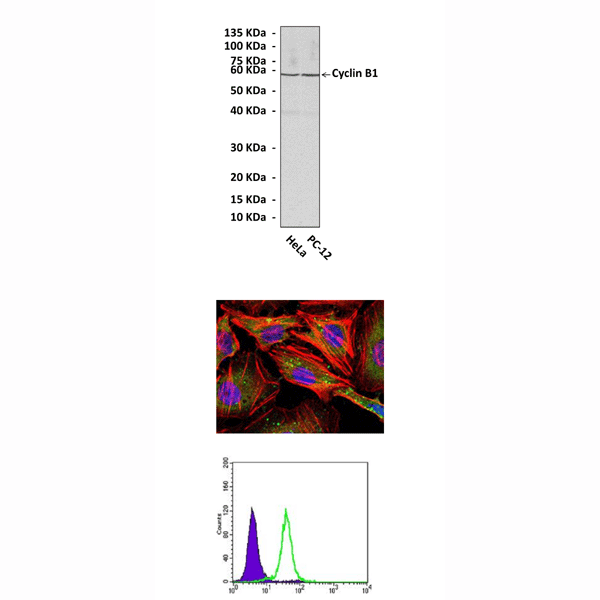Anti-Cyclin B1: Mouse Cyclin B1 Antibody |
 |
BACKGROUND Cyclins are highly conserved proteins that activate cyclin-dependent kinases (CDKs) to regulate the cell cycle, transcription and other cellular processes. There are several different cyclins that are active in different parts of the cell cycle and that cause the Cdk to phosphorylate different substrates. There are also several "orphan" cyclins for which no Cdk partner has been identified. For example, cyclin F is an orphan cyclin that is essential for G2/M transition. These cyclins can heterodimerize with specific catalytic subunits, Cdks, to form holoenzymes. Some substrates of these holoenzymes, which are inactivated upon phosphorylation, are pRB and the related proteins, p130 and p107. It is thought that phosphorylation and inactivation of pRB leads to progression through the restriction point.1 The ability of the cyclin/Cdk holoenzymes to phosphorylate pRB is inhibited by a family of small molecular weight proteins, known as cyclin-dependent kinase inhibitors (CKIs). The concentration of cellular cyclins varies in a cyclical fashion during the cell cycle; they are produced or degraded as needed in order to drive the cell through the different stages of the cell cycle. When concentrations in the cell are low, cyclins dissociate from Cdk, thus inhibiting enzymatic activity.2 Cyclins themselves have no enzymatic activity.
Cyclin B1 is a key molecule for G2-M-phase transition during the cell cycle, which accumulates in the cytoplasm during S and G2 phases, translocates to the nucleus before nuclear envelope breakdown during prophase. The nuclear entry of Cdc2–cyclin B1 during prophase is thought to be essential for the induction and coordination of M-phase events. Phosphorylation of cyclin B1 is central to its nuclear translocation. Polo-like kinase 1 phosphorylates cyclin B1 on Ser147 and Ser133, and targets it to the nucleus during prophase.3 Cyclin B1is overexpressed in various tumor types.4
Cyclin B1 is a key molecule for G2-M-phase transition during the cell cycle, which accumulates in the cytoplasm during S and G2 phases, translocates to the nucleus before nuclear envelope breakdown during prophase. The nuclear entry of Cdc2–cyclin B1 during prophase is thought to be essential for the induction and coordination of M-phase events. Phosphorylation of cyclin B1 is central to its nuclear translocation. Polo-like kinase 1 phosphorylates cyclin B1 on Ser147 and Ser133, and targets it to the nucleus during prophase.3 Cyclin B1is overexpressed in various tumor types.4
REFERENCES
1. Xiong, Y. & beach, D. Curr. Biol. 1:362-4, 1991
2. Pestell, R.G. et al: Endocrinol. Rev. 20:501-34, 1999
3. Toyoshima-Morimoto, F et al: Nature 410:215-20, 2001
4. Soria, J.C. et al: Cancer Res. 60:4000-4, 2000
2. Pestell, R.G. et al: Endocrinol. Rev. 20:501-34, 1999
3. Toyoshima-Morimoto, F et al: Nature 410:215-20, 2001
4. Soria, J.C. et al: Cancer Res. 60:4000-4, 2000
Products are for research use only. They are not intended for human, animal, or diagnostic applications.
Параметры
Cat.No.: | CP10281 |
Antigen: | Raised against recombinant human Cyclin B1 fragments expressed in E. coli. |
Isotype: | Mouse IgG1 |
Species & predicted species cross- reactivity ( ): | Human, Mouse, Rat |
Applications & Suggested starting dilutions:* | WB 1:1000 IP 1:50 IHC n/d ICC 1:50 - 1:200 FACS 1:50 - 1:200 |
Predicted Molecular Weight of protein: | 58 kDa |
Specificity/Sensitivity: | Detects endogenous Cyclin B1 proteins without cross-reactivity with other family members. |
Storage: | Store at -20°C, 4°C for frequent use. Avoid repeated freeze-thaw cycles. |
*Optimal working dilutions must be determined by end user.
Документы
Информация представлена исключительно в ознакомительных целях и ни при каких условиях не является публичной офертой








